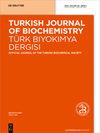基于序列的多脂耶氏菌星形网络分析
IF 0.7
4区 生物学
Q4 BIOCHEMISTRY & MOLECULAR BIOLOGY
Turkish Journal of Biochemistry-turk Biyokimya Dergisi
Pub Date : 2014-01-01
DOI:10.5505/TJB.2014.75768
引用次数: 1
摘要
目的:本研究的目的是:首先,对已鉴定的多脂乳杆菌有或没有外群的系统发育树进行星形网络分析;其次,显示系统发育树中外群的冗余性。材料与方法:本研究选取22株经26S rDNA区D1/D2结构域测序鉴定的多脂耶氏菌,采用邻域连接法和不含外群的邻域连接法重建了2个系统发育树。对这两种系统发育树进行了星形加权网络分析。结果:我们的带外群的加权系统发育网络的邻接矩阵形式看起来像一个有向星图邻接矩阵。权值最低的是从中心节点到假丝酵母外群的边缘(0.00008),对应的边缘最窄。然而,从中心淋巴结到脂性耶氏菌TEM YL 19的边缘重量为0.0825,结构最厚。结论:网络分析结果表明,亲缘品系与亚种之间的系统发育关系是可以确定的,且该系统发育树中的外类群由于其平均加权程度的变化可以忽略不计本文章由计算机程序翻译,如有差异,请以英文原文为准。
Star network analysis of sequence based identified Yarrowia lipolytica strains
Aim: The objectives of this study are, first, to investigate a star network analysis of phylogenetic trees of identified Y. lipolytica strains with or without one out-group, and secondly, to show the redundancy of the out-groups in phylogenetic tree. Material and Methods: In this study we used 22 Yarrowia lipolytica strains which were identified with sequencing of D1/D2 domain of 26S rDNA region, two phylogenetic trees were reconstructed by the neighbor joining method including an out-group or not. The star- like weighted network analysis of these two phylogenetic trees was investigated. Results: The adjacency matrix formalism of our weighted phylogenetic network with the out- group looks like a directed star graph adjacency matrix. The lowest weight is the edge from the central node to Candida sake out-group (0.00008) corresponding to the narrowest edge. However, the edge going from central node to Yarrowia lipolytica TEM YL 19 has a weight of 0.0825 and the thickest structure. Conclusion: Thus network analysis show that phylogenetic relationship between close strain and subspecies can be confirmed and also the out-group in this phylogenetic tree is unnecessary due to the negligible change in the average weighted degree and its some
求助全文
通过发布文献求助,成功后即可免费获取论文全文。
去求助
来源期刊
CiteScore
1.20
自引率
0.00%
发文量
0
审稿时长
6-12 weeks
期刊介绍:
Turkish Journal of Biochemistry (TJB), official journal of Turkish Biochemical Society, is issued electronically every 2 months. The main aim of the journal is to support the research and publishing culture by ensuring that every published manuscript has an added value and thus providing international acceptance of the “readability” of the manuscripts published in the journal.

 求助内容:
求助内容: 应助结果提醒方式:
应助结果提醒方式:


